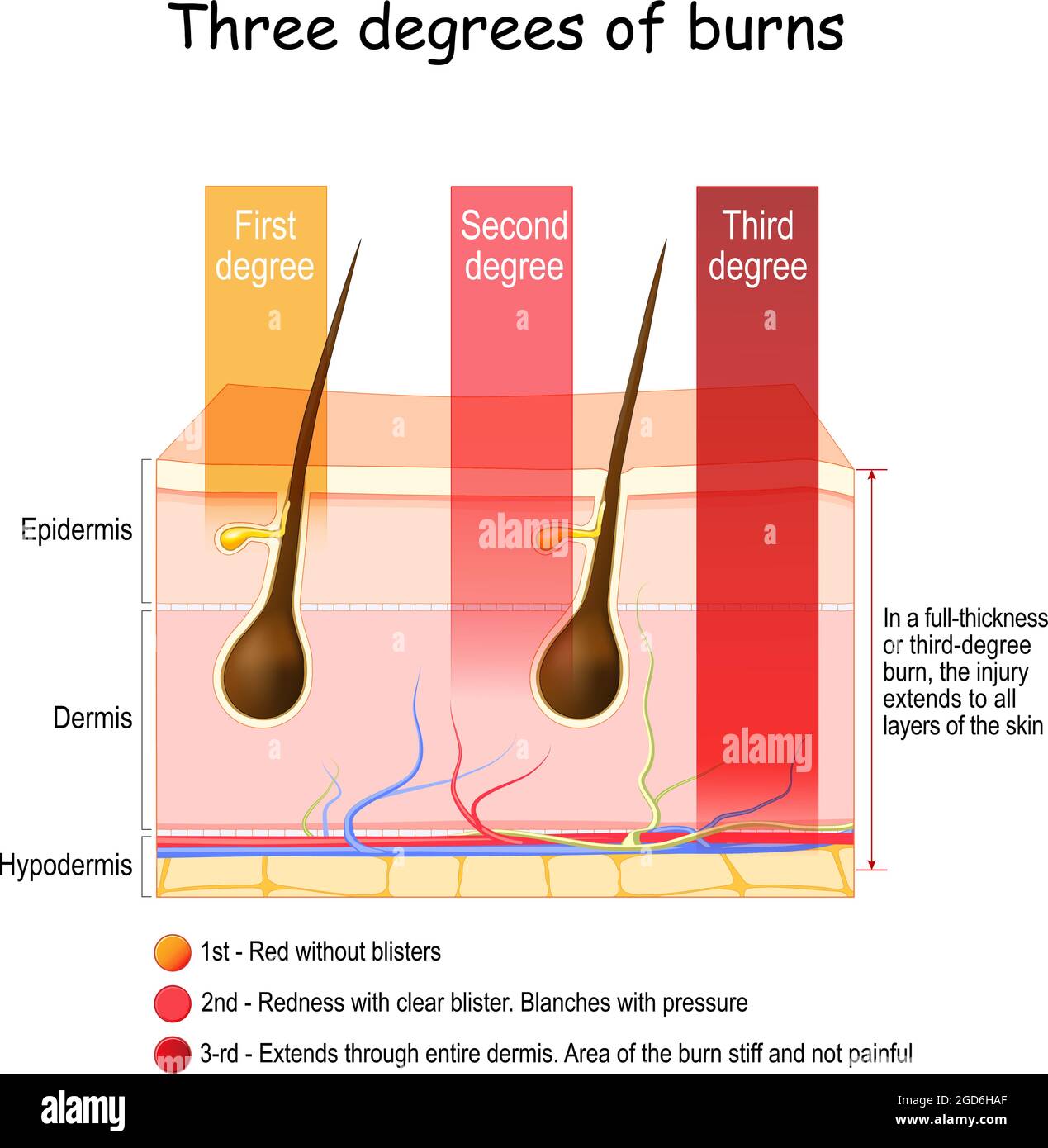Understanding Burn Degrees: A Comprehensive Guide
Burn injuries can range from mild discomfort to life-threatening conditions, depending on the degree of damage to the skin and underlying tissues. Understanding the different burn degrees is crucial for proper treatment and recovery. From superficial burns to deep tissue damage, each degree requires specific care and attention. In this article, we will delve into the classification of burn degrees, the symptoms associated with each type, and the treatment options available. Whether you're a healthcare professional or someone seeking information for personal use, this guide aims to provide clarity and actionable insights.
Burns are a common injury that can occur in various settings, from accidental kitchen mishaps to severe industrial accidents. The severity of a burn is determined by its depth and extent, which is categorized into different degrees. Knowing how to identify and respond to burn injuries can significantly impact the healing process and long-term outcomes. This article will explore the nuances of each burn degree, offering a detailed explanation of what to expect and how to manage each type effectively.
As we proceed, you'll discover the importance of recognizing the signs of different burn degrees and the steps you can take to ensure proper care. From first-degree burns that cause redness and pain to third-degree burns that penetrate deep into the skin, understanding the distinctions is vital for both immediate and long-term treatment. Let’s dive deeper into the world of burn injuries and explore the critical aspects of burn degrees explained.
Read also:Joey Witherspoon The Rising Star Of Jockeydom
What Are the Different Types of Burn Degrees Explained?
Burn injuries are classified into three primary degrees, each representing varying levels of skin damage. First-degree burns are the mildest, affecting only the outer layer of the skin, while third-degree burns penetrate all layers, causing significant damage. Understanding these classifications is essential for determining the appropriate treatment plan. Below, we outline the key characteristics of each burn degree to help you identify and address burns effectively.
How Do First-Degree Burns Differ from Higher Degrees?
First-degree burns, often referred to as superficial burns, primarily affect the epidermis, the outermost layer of the skin. Symptoms include redness, swelling, and mild pain. These burns typically heal within a week without scarring. Unlike higher-degree burns, first-degree burns do not involve blistering or damage to deeper skin layers. Recognizing the signs of a first-degree burn is crucial for timely intervention and preventing complications.
Can Second-Degree Burns Lead to Scarring?
Second-degree burns extend beyond the epidermis, reaching the dermis, the second layer of skin. These burns are characterized by severe pain, redness, swelling, and the formation of blisters. While they heal within two to three weeks, second-degree burns can lead to scarring, especially if not treated properly. Proper wound care, including cleaning and dressing, is essential to minimize scarring and promote healing. Understanding the implications of second-degree burns is a critical aspect of burn degrees explained.
What Are the Symptoms of Third-Degree Burns?
Third-degree burns are the most severe, penetrating all layers of the skin and potentially affecting underlying tissues. These burns can appear charred or white and may cause numbness due to nerve damage. Unlike first and second-degree burns, third-degree burns do not typically cause pain because of the extensive nerve damage. However, they require immediate medical attention and often necessitate skin grafts for proper healing. Recognizing the symptoms of third-degree burns is vital for ensuring timely and appropriate treatment.
How Are Burn Degrees Diagnosed?
Diagnosing burn degrees involves a thorough examination of the affected area to determine the extent of skin damage. Healthcare professionals assess the burn's depth, size, and location to classify it accurately. This process is crucial for developing an effective treatment plan tailored to the severity of the injury. Below, we explore the diagnostic methods used to evaluate burn injuries and ensure proper care.
Is It Necessary to Seek Medical Attention for All Burn Degrees?
While minor burns, such as first-degree burns, can often be treated at home, more severe burns require professional medical evaluation. Third-degree burns, in particular, demand immediate attention due to their potential to cause complications like infection and shock. Understanding when to seek medical help is a key component of burn degrees explained. By recognizing the signs of severe burns, individuals can ensure timely intervention and improve recovery outcomes.
Read also:Understanding The Dynamics Of Home Security A Guide To Buscar Kid And Mom Cctv
What Are the Treatment Options for Each Burn Degree?
Treatment for burn injuries varies depending on the degree of the burn. First-degree burns can usually be managed with over-the-counter pain relief and cool compresses. Second-degree burns may require antibiotic ointments and sterile bandages to prevent infection and promote healing. Third-degree burns often necessitate hospitalization, skin grafts, and specialized wound care. Exploring the treatment options for each burn degree is essential for ensuring optimal recovery and minimizing complications.
What Are the Long-Term Effects of Burn Injuries?
Burn injuries can have lasting effects, particularly in cases of severe burns. Scarring, contractures, and psychological impacts are common long-term consequences. Proper rehabilitation and follow-up care are crucial for addressing these effects and improving quality of life. Below, we discuss the potential long-term impacts of burn injuries and the strategies for managing them effectively.
Burn Degrees Explained: How Can Scarring Be Minimized?
Scarring is a common concern following second and third-degree burns. Advanced wound care techniques, such as silicone gel sheets and pressure garments, can help minimize scarring. Additionally, early intervention and proper wound management play a significant role in reducing the likelihood of severe scarring. Understanding the factors that contribute to scarring is an integral part of burn degrees explained, empowering individuals to take proactive steps toward recovery.
Can Psychological Support Aid in Burn Recovery?
Burn injuries can have profound psychological effects, including anxiety, depression, and post-traumatic stress disorder (PTSD). Psychological support, such as counseling and support groups, can be invaluable in the recovery process. By addressing the emotional and mental aspects of burn injuries, individuals can achieve a more holistic recovery. Incorporating psychological support into the treatment plan is a key consideration in burn degrees explained.
What Are the Prevention Strategies for Burn Injuries?
Preventing burn injuries involves adopting safety measures in various environments, from the home to the workplace. Installing smoke detectors, using flame-retardant materials, and practicing safe cooking habits are just a few examples of effective prevention strategies. Educating individuals about burn prevention is a vital component of burn degrees explained, helping to reduce the incidence of burn injuries and their associated complications.
Conclusion
Understanding burn degrees explained is essential for recognizing the severity of burn injuries and ensuring proper care. From first-degree burns that cause mild discomfort to third-degree burns that require specialized treatment, each degree demands a unique approach. By familiarizing yourself with the signs, symptoms, and treatment options for each burn degree, you can take proactive steps toward recovery and prevention. Remember, seeking professional medical advice is crucial for severe burns, and adopting preventive measures can significantly reduce the risk of burn injuries.
Table of Contents
- Understanding Burn Degrees: A Comprehensive Guide
- What Are the Different Types of Burn Degrees Explained?
- How Do First-Degree Burns Differ from Higher Degrees?
- Can Second-Degree Burns Lead to Scarring?
- What Are the Symptoms of Third-Degree Burns?
- How Are Burn Degrees Diagnosed?
- Is It Necessary to Seek Medical Attention for All Burn Degrees?
- What Are the Treatment Options for Each Burn Degree?
- What Are the Long-Term Effects of Burn Injuries?
- Burn Degrees Explained: How Can Scarring Be Minimized?
- Can Psychological Support Aid in Burn Recovery?
- What Are the Prevention Strategies for Burn Injuries?
- Conclusion
Article Recommendations


